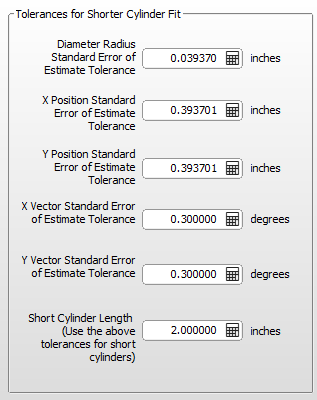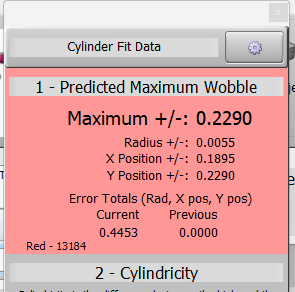Cylinder Fit Data Window
How Does VTube-LASER Use Cylinder Fit Tolerances?
| VTube-LASER uses scanned surface points to calculate tube centerlines. Regular tube scans assume that the primitive shape to solve for is a cylinder. But we also assume that no cylinder that we measure in the real world is a perfect cylinder. VTube-LASER has to overcome this issue when measuring tube straights. Also, because of this, it's important for you to know the estimated accuracy of the calculation when fitting to the centerline. The estimated accuracy helps you know how confident you can be with the centerline position. |
|
The Cylinder Fit Data Window Reports How Well the Centerline Fits the Surface Data
After calculating a cylinder centerline from surface points, VTube-LASER reports how well the centerline FITS the surface points of the cylinder. These values are shown in the Cylinder Fit Data window.
These estimate values are calculated using statistics. The values are standard deviation x 2, which means that it gives a 95% assurance that the these values are the precision of the positions. |
|
Cylinder Wobble - The highest of the X or Y values
To simplify visualizing the X and Y positions, we say that the highest of the X and Y values is the "cylinder wobble". The cylinder wobble in the example on the right is 0.2290 inches - because it is the higher of the two values. |
|
Controlling Cylinder Fit Tolerance Values
VTube-LASER uses tolerance values to decide when to warn you about potentially poor cylinder measurements.
These values can be adjusted in the Measure 1 menu of System Options.
Default Tolerances
|  |
How to Test for and Use Cylinder Fit Tolerances for Your Application
You can adjust the tolerances in System Options to better fit your application and increase the assurance that your centerline is a good fit to the surface data. Test for ideal cylinder fit tolerance settings by measuring tubes and watching the tolerance values in the Cylinder Fit window. |  |
As an example, if you never see deviations over 0.0100" (like shown on the right), you could set the tolerance value to 0.020" (which is just over double the max observed). If a cylinder fit deviation exceeds double the norm, then you can safely assume that there is a problem in the measurement, and you should be warned. When watching for these values during measurements, keep in mind that you need to consider both the longer straight and shorter straight tolerances. Short straights will nearly always need higher tolerances. To change the default values, be sure to CLEAR the VTube-LASER project first, then press the "Set Project Default State to the current state" button. This will use the new default cylinder fit tolerances for all new projects. |  |
Why Are There Separate Values for Shorter Straights?
|  |



